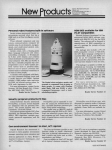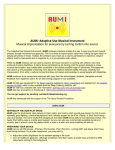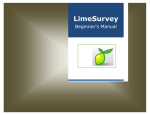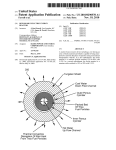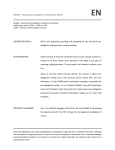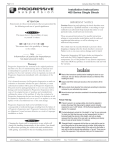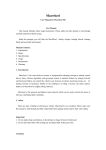Download The story is told of a man who was spotted rumbling through
Transcript
Donna Maria’s Handmade Beauty University Sponsored by the Handmade Beauty Network, LLC PO Box 158, Bowie, MD 20719-0158 (301) 464-4515 (p.) | (301) 464-2719(f.) [email protected] | www.HandmadeBeauty.com The story is told of a man who was spotted rumbling through drawers and pockets, and looking under furniture in an obvious desperate search for something. "What are you looking for?" asked an onlooker. "I cannot seem to find my keys," replied the man. "I have been looking very hard and I've searched all over, but I just can't seem to find them anywhere." The onlooker replied, "Are you sure you lost them over here? Perhaps you lost them over there. Let's go look; I'll help you." The man paused and considered the offer carefully, and then replied, "No, thank you. I don't want to look over there. It's too dark." This parable describes the lives of far too many people today. They are wallowing in a sea of discontent, certain that a key that will unlock the door to happiness in their lives is somewhere, yet determined to search for it in all the wrong places. Congratulations to you for not being like this man! If you are reading this page, you are indeed different! Not only have you found something that you love to do and which brings you great joy, but you have also decided to be proactive about finding the keys to make it successful as a business. I am delighted and honored that you found me and the Handmade Beauty University, I am grateful for the opportunity to contribute to your success and perhaps even experience it with you! My hope and prayer is that through HBU, you will discover hundreds of keys that will help you unlock the door to success in the handmade beauty business, and you will do it in a fraction of the time that others will because you have chosen to invest in yourself. Through HBU, you will learn to avoid many of the mistakes I and others made on the path to success and you will enter (or re-enter) the market with confidence and fortitude, ready to propel your business and yourself to the “next level.” These written materials are to be used in conjunction with the telenars of the Handmade Beauty University. While they are useful without HBU’s telenars, they are far more helpful if they are enjoyed in conjunction with the telenars. For more details about HBU’s telenars, please visit http://www.handmadebeauty.com/hbu/index.asp May you find within HBU and these pages the inspiration and strength you need to break all the rules, climb your own corporate ladder and create the life you love through your handmade beauty business. Let the journey begin. Best & Success! dM © 2004. The Handmade Beauty Network, LLC. All Rights Reserved. Unauthorized duplication is prohibited. For permission to duplicate, please contact HBN at [email protected]. www.HandmadeBeauty.com | [email protected] | (301) 464-4515 (p.) | (301) 464-2719 (f.) 2 Telenar #5: Internet and Website Solutions & Email Newsletters (Untangling the Web We Weave)_________________________ I. Using The Internet To Grow Your Business Who could have known that what began in the early 1970s as a means to allow computers to communicate seamlessly across multiple independently owned networks would blossom into one of the most valuable and accessible tools in human history!? Perhaps no group of people has become as adept at using the Internet as small business owners. From communicating the best your business has to offer to serving as an efficient and cost effective way to process orders, the Internet is one of the most indispensable items in your small business arsenal. If you had started your business as few as 5 years ago, you may very well have been able to get away with a rudimentary understanding of how to use the Internet as a businessperson. That is no longer the case. Your success in business depends in great part on a keen appreciation for the ways in which you can use and misuse the Internet, on an understanding of its limits and on your willingness and ability to adapt to the dynamic technologies and protocols it uses. The Internet is a treasure trove of information that you can use to research your business before it starts and prepare your business plan. As you start your venture, you can use the Internet to find out what your future competitors are doing, research trends in your industry and learn what looks good and bad at websites so you can avoid the mistakes of others and emulate those things that appeal to you. You can use the Internet to find service providers to help you launch and grow your business – ingredients, packaging supplies, website designers, attorneys, printers, graphics designers, computer software. If you can call its name, you can find it on the Internet. Since most beauty businesses reading these materials are keenly interested in how to design and launch an attractive and fully functional website, this chapter focuses largely on this area. This matrix shows the minimum page components of a solid website. Page Title Home Purpose & Page Contents Present a good first impression. Encourage visitors to click deeper within the site. Clear product photo(s), business name and/or logo and clearly visible navigation tools so visitors can easily visit other pages in the site. Attractive colors, easy to read type on white or light background. Link to other pages to encourage length of stay. Notes Logos should not overwhelm product photos. A group product photo on the home page is nice. Individual shots of individual products work best in the shopping area. © 2004. The Handmade Beauty Network, LLC. All Rights Reserved. Unauthorized duplication is prohibited. For permission to duplicate, please contact HBN at [email protected]. www.HandmadeBeauty.com | [email protected] | (301) 464-4515 (p.) | (301) 464-2719 (f.) 3 About (Us) Describe yourself and your business. Include interesting tidbits and photos if appropriate to tell your story. Link to other pages in the site to encourage length of stay. Press To demonstrate your company’s visibility in the media and make it easy for the press to contact you. Products/Shop (can be titled Overview of your products, describing attributes and in any way to indicate a how to buy. Photos should place to go shopping) be clear and crisp with little or no props. This area clearly itemizes what you sell and makes it easy for people to buy. Other Other pages/links you might wish to add: contact, coming soon, legal, privacy, where products are sold (if you wholesale or sell outside your website), email newsletter, search window, sign in/registration, craft/trade shows, new products, kits, apparel, testimonials. You also want to include a link to a shopping basket (or cart) so your customer can see at any time what is in their basket. Include how you got started, awards you’ve won, industry organizations you belong to, link to any other appropriate sites you own. Include your news and press releases and downloads of favorable editorial reviews. Make it easy and enjoyable for customers to buy your products. You want your customers to leave with the product(s) they want, saying, “Wow! That was easy and fun!” While there is no end to the ways in which your website can be used to enhance and grow your business, there are 3 fundamental keys to maximizing it for your success: • • • Your website as a communications tool Your website as a sales tool Your website as a marketing tool © 2004. The Handmade Beauty Network, LLC. All Rights Reserved. Unauthorized duplication is prohibited. For permission to duplicate, please contact HBN at [email protected]. www.HandmadeBeauty.com | [email protected] | (301) 464-4515 (p.) | (301) 464-2719 (f.) 4 1. Your Website As A Communications Tool By far the most valuable thing the Internet can help you do is exchange information with other people in the world. Notice I said, “exchange.” In other words, the Internet is not meant to be a one-way street. The power of the Internet is not fully realized for any business until its ability to help you exchange information with others is realized. For example, your website communicates that you have a line of body butters and sugar scrubs in 10 fragrances. It also communicates that your products are all made by hand from scratch with organic sugars and oils. So what? Those words mean absolutely nothing unless they are communicated in a way that creates a desire on the part of the reader to engage in some type of exchange with respect to that information. It could be an exchange of money for products or it could be a verbal exchange with you in the form of a phone call to ask you if you can customize a gift basket. It could also be an exchange with a third party as your site visitor tells someone else about you. Whatever the case, everything on your website should be geared toward encouraging some kind of exchange with the visitors to your website. Every bit of information placed at your website should be geared toward inviting visitors to engage in a positive exchange of information with you or another person, with the inevitable result being a benefit to you and your business. That’s why it is important that the website copy be clearly, concisely and legibly written, that it be grammatically correct, that all photographs be crystal clear and attractive and that any audio be relevant and easy to understand. 2. Your Website As A Sales Tool No doubt the Internet is one of the most valuable sales tools a small business owner will ever use. At GoDaddy.com, you can reserve a .com domain name for $8.95 per year (.75 cents a month), purchase hosting services for $3.95 per month, lease a basic secure shopping cart for $9.95 a month and order a website template CD for $24.95.1 Total cost: $207.70 or $16.72 per month. It would probably cost far more than that to rent an empty hole in a dingy wall in a plastic strip mall in the smallest county in the United States! Of course a lot goes into making this investment of $207.70 turn a profit, but my point is that the basic sales tools designed for the Internet are not costly. Whatever your budget, if you can cover the costs of those tools during the first few months of your business, you have taken the first baby steps toward successfully using the Internet as a vehicle to generate sales. Once you have the basics in place (domain, hosting, shopping cart and website design and content), you will be able to phase in additional bells and whistles – an email newsletter, search engine submission and optimization, online advertising, affiliate programs and more. 1 These figures are a guide only, reflecting the basic services and prices as described at GoDaddy.com as of December 2004. Additional fees may apply at the discretion of the company. © 2004. The Handmade Beauty Network, LLC. All Rights Reserved. Unauthorized duplication is prohibited. For permission to duplicate, please contact HBN at [email protected]. www.HandmadeBeauty.com | [email protected] | (301) 464-4515 (p.) | (301) 464-2719 (f.) 5 Of all of the things you will use to maximize the Internet as a sales tool, perhaps none is more important than the inclusion of a secure shopping cart at your website. A secure cart costs more than an non-secure one, but it is well worth the incremental cost to assure your customers that their personal information (especially credit card details) are protected to the best of your ability from hackers who troll the Internet to steal this kind of information. Your website should employ the highest level of commercially available encryption which scrambles all of the information your customer shares with you through the secure portions of your website so that third parties cannot steal it. This “scrambling” converts the information into gibberish, and it should take place in at least two places: first, between the customer and your browser or whatever mechanism you use to collect the personal information, and second, at the location where the customers’ personal data is stored before you (or your financial institution) download and process it. Any passwords to access this secure information should be changed frequently. Your secure shopping cart should also display two visuals that are key to alerting your customer that the cart is secure. First. An “s” should appear in the website browser, so that http://www.yoursite.com automatically becomes https://www.yoursite.com when your customer is on the secure portion of your site. Second, in the bottom right hand corner of the browser, there should appear a picture of a small gold padlock showing the customer that she has entered an area of the site that is secure. If you’d like, you can purchase the rights to display security certificates at your website so your customers can quickly and clearly see that all commercial transactions are processed with their security in mind. Check with your hosting and/or e-commerce company for details on other options available to assure your customers that you value their privacy and are doing everything possible to make the online purchasing process as risk free as possible. Because online buyers tend to buy on impulse with a “go to it, see it, buy it without much work” mentality, a website without a secure shopping cart generally will not generate enough sales to make opening up an online business worth your while. Now that a shopping cart with merchant services (allowing acceptance of major credit cards and PayPal2) can be installed on a site at a reasonable price, the days of printing out order forms (at least in the retail arena) are pretty much gone for business expecting to generate most of their sales online. If you cannot afford a shopping cart and/or merchant account, you can use a service like that offered by CCNow, which provides comprehensive secure online checkout and order tracking services.3 2 PayPal, owned by eBay, allows online merchants to accept payments from online shoppers who are members of PayPal. PayPal allows its members to open accounts on which they can draw to make online purchases. Buyers must be PayPal members in order to utilize this form of payment. Because some online shoppers are reluctant to give their private information to PayPal, you can expect that some sales will be lost if PayPal is your only online payment method. 3 There are several drawbacks to CCNow. First, it charges a 9% processing fee. Second, there’s a monthly mandatory $9.95 “promotional fee.” Third, your customer must actually leave your site and go to the ccnow.com site to complete a transaction. When you add up these fees and charges, you may ultimately be better off investing in your own merchant program. For details, visit www.ccnow.com. To investigate setting up your own program, contact your local bank or any of the major credit card companies including MasterCard, Discover, Visa and American Express. © 2004. The Handmade Beauty Network, LLC. All Rights Reserved. Unauthorized duplication is prohibited. For permission to duplicate, please contact HBN at [email protected]. www.HandmadeBeauty.com | [email protected] | (301) 464-4515 (p.) | (301) 464-2719 (f.) 6 Because the main goal of your website is to sell products, the site content should be sales oriented. That is, while there may be pages at your site that are not completely devoted to closing a sale, the site content should be prepared so that it encourages sales and influences site visitors in that direction. If you are not a good writer, consider using a writer or editor to help you prepare website content. I recently read an article in a major newspaper citing a study finding that a major reason for lost online sales is that the shopping cart is not user friendly or requires that the customer make too many clicks to accomplish the sale. The study concluded that dollars literally go down the drain with every click that a customer views as unnecessary. Test your cart for user friendliness and ease of use. Is there room for any “click consolidation”? Ask your friends to place some test orders and provide you with feedback on how smooth the ordering process is at your site Ask them to check for everything, even simple things like whether the typeface is too small or otherwise difficult to read. Review their feedback and make adjustments to maximize your website for online sales. 3. Your Website As A Marketing Tool As we discussed in Telenar #6 (Publicity & Public Relations (The OR of PR)), marketing is loosely defined as just about anything you do to spread the word about your business to the various “publics” that affect your bottom line. There is no limit to the number of ways a business can and must deal with its “publics,” but the Internet – particularly through your website – is one of the most effective ways to do it. To use your website as an effective marketing tool, you must first define who the various “publics” are and make sure that the content at the site specifically addresses each one. A handmade beauty business owner must cater to at least 3 publics: • • • Buying public (consumers) Media public Information gathering public a. The Buying Public In terms of your bottom line, the buying public is obviously of paramount importance to your business. This means that from the home page to your shopping cart and exit messaging,4 your site should display your products and services in the most attractive manner possible and provide an overall pleasing shopping experience. Consider all of these things when designing a site with your buying public in mind, remembering that the goal with a consumer is to make a sale: 4 Exit messaging describes the manner in which you conclude an online sale by doing such things as thanking your customer for a purchase, letting them know you appreciate their business, inviting them to tell a friend, etc. © 2004. The Handmade Beauty Network, LLC. All Rights Reserved. Unauthorized duplication is prohibited. For permission to duplicate, please contact HBN at [email protected]. www.HandmadeBeauty.com | [email protected] | (301) 464-4515 (p.) | (301) 464-2719 (f.) 7 ~ if possible, use the domain name that corresponds directly, character for character, with your business name so it is easy for customers to remember where to find you on the web ~ choose attractive, easy to read color schemes: keep glaring colors to a minimum; make sure the type is easy to read against the background color (you can’t go wrong with a dark typeface against a white background) ~ select one typeface: be kind to your customers’ eyes and make sure the type is large enough to read; avoid fancy typefaces that are hard to read, especially if they are in paragraph text ~ link between pages to highlight points of particular interest and to maximize search engine returns – for example, if a customer has placed Item A in their shopping cart, insert a message letting them know that other customers who purchased Item A also liked Item B, and include other links of interest so your site has depth and character ~ mix in some testimonials from other customers about how much they enjoyed your products ~ include visually pleasing graphics and use photographs of products and other relevant scenes to encourage sales; photographs and graphics should generally be a minimum of 72 dpi and should be clear and crisp – not fuzzy or murky; if a page includes a lot of graphics, display them in a way that is not busy or annoying that your website ~ create easy to use navigation tools like tabs and buttons to identify the information a customer can find on different pages within your website – a tab for soaps, a tab for FAQs a tab for privacy/legal information, a tab for information about you, etc. b. The Media Public Don’t forget the media when setting up your website. While you may not actively interact directly with members of the press on a regular basis, if a reporter or writer finds your website, they are often not there to buy anything. Instead, they are there to see if your site contains anything that might be of interest to their readers. Include a “media” or “press” link at your site to make it easy for reporters and writers to find information that is packaged especially for them. Include within this page copies of news releases,5 reprints of your company features in newspapers and magazines, links to other websites that have included favorable editorial content about your products, etc. No matter how suitable your products are for feature in a publication, you will hardly ever be featured if it is hard for a writer to determine how to get in touch with you. Be sure to make it easy for the media to contact you using all available communications methods: email, phone, snail mail, pager, cell phone, instant messaging, fax, etc. 5 An effective way to display press releases is in PDF format. © 2004. The Handmade Beauty Network, LLC. All Rights Reserved. Unauthorized duplication is prohibited. For permission to duplicate, please contact HBN at [email protected]. www.HandmadeBeauty.com | [email protected] | (301) 464-4515 (p.) | (301) 464-2719 (f.) 8 c. The Information Gathering Public To some extent, the information gathering public consists of the media, which is obviously in the business of gathering and disseminating information, and buying customers, who are interested in buying from people they trust. Other information gatherers are people wishing to learn more about you for their own personal purposes. For example, your site visitors might be interested in knowing a little bit about you and how you got started in business. This kind of historical information is useful because people are increasingly interested in doing business with people who have stories that they can identify with. You can leverage the power of your past to your benefit by including it at your website. Another type of information to consider including are your personal recommendations for products and services you use yourself. The best cooking spices, the most unique clothing accessories, your preferred charities (spread the word if you donate proceeds to them!) or your favorite brand of chocolate bar. These types of information “sound bytes” help give you and your website depth and texture and help encourage a tangible relationship with everyone who visits. Other information gatherers include your competitors and would be competitors who are looking at your site to gather ideas for their own business. You want to look good for everyone so set up the best site possible with the resources you have, and be sure to budget for growth into the future. 4. The Limitations of the Internet The Internet is largely unproven as a sales vehicle and most new business owners know very little about it. Yet it is often the only sales tool a new entrepreneur can afford. Despite its considerable positive attributes, the Internet has several built in limitations and potential pitfalls. With all its benefits, the Internet is and probably always will be a poor substitute for true human interaction. You don’t have to be a genius to know that the more one on one interaction you have with a customer, the more sales you will enjoy. The Internet is a poor excuse by itself for this type of interaction, but it can enhance other more proven methods of communication. Long before the Internet, there was direct mail. And there is still direct mail – lots of it. Why do multi-million dollar corporations spend millions of dollars a year on direct mail? Because it works. Because despite our fascination with the Internet and its many benefits, we still like to hold things in our hands every now and then. We are tactile creatures, and as we move further into the New Millennium, millions of us are literally starving for personal interaction in our technologically advanced global economy. With or without a website, direct mail has been a successful sales and marketing vehicle for hundreds of years. You can get 5,000 2-sided full color 4 x 6 post cards printed for as little as ½ cent each. If you round that figure up to a penny (to cover your time to print labels and mail cards), it costs no more than .40 cents to enjoy face-to-face contact with customers you want to reach with your message. You can purchase or rent a mailing list from most magazine publishers catering to our industry. Publications such as © 2004. The Handmade Beauty Network, LLC. All Rights Reserved. Unauthorized duplication is prohibited. For permission to duplicate, please contact HBN at [email protected]. www.HandmadeBeauty.com | [email protected] | (301) 464-4515 (p.) | (301) 464-2719 (f.) 9 Herb Quarterly, Body & Soul and The Herb Companion sometimes make their mailing lists available. Don’t forget to place phone calls and send written notes every now and then to your most valued customers and prospects. Again, email may be efficient but it may not be the most effective way to close a sale or massage a good business relationship. II. Making Your Website Shine So you’re not a technological whiz with an HTML background? Don’t despair! No matter how many (or few) resources you have, you can set up and maintain a website of your own. While an in depth discussion of all of the issues involved in website design and maintenance is beyond the scope of this telenar, there are at least 4 broad areas to concern yourself with when it comes to website design: (1) design and overall website look; (2) shopping; (3) customer contact; and (4) visibility. Each of these categories includes dozens if not hundreds of specific issues, the most significant of which are discussed here. 1. Design and Overall Website Appearance It goes without saying that while your website need not be professionally designed, it should be professional. This means that if at all possible, it should be located at a domain name that corresponds with your business name.6 Its content should be well written and free of grammatical errors. The typeface should be sufficiently large that most site users would not have trouble reading it, the font should be easy to read (save the fancy fonts for logos and other artistic renderings) and the colors should not clash. Dark writing on a light background is always safe. Photos must be crystal clear and free of props that have nothing to do with your products. Before designing your website or hiring a professional, be sure to investigate all of your options and evaluate all costs. a. Designing Your Own Website To design your website, you can do it yourself, hire a professional, or use a combination of the two. Due to the large number of website editing software programs available today, designing and maintaining your own website is not as daunting as it once was. The most popular and user friendly programs are Macromedia Dreamweaver7, Microsoft Front Page8, Adobe Go Live9 Each of these programs can be purchased via snail mail (which usually includes a hard copy of the user’s manual) or via download for 6 More information about the importance of choosing a domain name that corresponds to your business name is discussed in Telenar #4: Branding & trademarking (When Good Things Happen To Your Good Name). 7 http://www.macromedia.com/software/dreamweaver/ 8 http://office.microsoft.com/en-us/FX010858021033.aspx 9 http://www.adobe.com/products/golive/main.html © 2004. The Handmade Beauty Network, LLC. All Rights Reserved. Unauthorized duplication is prohibited. For permission to duplicate, please contact HBN at [email protected]. www.HandmadeBeauty.com | [email protected] | (301) 464-4515 (p.) | (301) 464-2719 (f.) 10 immediate access and use. Some software providers offer free 30-day trials and customer service plans can usually be purchased for an additional fee. You may also be able to buy some web design software packaged with photo editing software, which can be invaluable if you are taking and editing your own product photos using a digital camera. If designing your website from scratch yourself seems a bit daunting, another “do it yourself” option is to buy a website template which you can modify for your own purposes. Website templates are easy to find online and good ones offer professional designs at a fraction of the cost of customized sites. The drawback is that literally hundreds of competitors could be using the same template as you and this does not serve to set you apart from the pack. Additionally, you may still want to invest in software design packages such as those discussed above to maintain your website. Some companies that offer templates also offer hosting services and other services that might be useful to you as an online merchant so be sure to ask they these types of “value added” services are provided at a discount price if a template is purchased. b. Hiring A Professional While hiring a professional website designer can be scary, I highly recommend it, especially if your business plan includes generating the bulk of revenue through online sales. A professional designer has the experience to know what works and what does not work on the Internet so you can get the most for your dollar and few resources (your time and your money) are wasted. Perhaps the most common mistake made by beauty business owners is believing that a cheap website can generate a lot of sales. It cannot. If I had a dime for every beauty business owner with a horror story about how they tried (and failed) to design a useful website, I could probably retire. Here are the top 10 questions to ask before hiring a professional website designer. 1. What are the best representations of your work? To answer this question, visit the designer’s website before you contact him personally. Observe whether it is user friendly, aesthetically pleasing and easy to read. See for yourself how the site reflects the designer’s creative talents. View the designer’s portfolio so you can see real life examples of sites she has designed for others. Examine the sites in the portfolio to determine whether you like them enough to contact the designer for further details. If a designer does not have an online portfolio, it either means they don’t have one (perhaps because they don’t have any clients yet) or they think enough of their work to display it at their site. Either way, don’t waste time on a designer whose site does not display their work. Since it often indicates a commitment to the web design industry, check the site to see if the designer is a member of any professional website design trade organizations. 2. Who are your references? If a designer’s site and portfolio appeal to you, contact her by email letting her know you would like the names of some references you can contact. The designer should have the names of 3 or 4 clients who are pleased enough with her work to serve as references. If © 2004. The Handmade Beauty Network, LLC. All Rights Reserved. Unauthorized duplication is prohibited. For permission to duplicate, please contact HBN at [email protected]. www.HandmadeBeauty.com | [email protected] | (301) 464-4515 (p.) | (301) 464-2719 (f.) 11 you hear nothing back or the designer says there are no references, scratch that designer off of your list and move onto the next one. If you get some contact names, email or call the references and ask them what they liked and disliked about the designer. Some especially important questions include how timely and professional she is both in terms of answering questions and launching a new site, how available he is by phone and email, how honest she is about her capabilities and whether she displays exceptional creative and innovative capabilities. If the references are good, email the designer to let her know you’d like more information about her services. (The rest of the questions here are ones to ask once you get to this point.) 3. What do you use to design and set up websites? This is an important question for two reasons. First, if you plan to use your own website design software to maintain your own website after it launches, you want to make sure that your designer’s software is compatible with yours. Second, you want to make sure that the designer is not restricted to website design software, which can sometimes be limited in terms of what it can and cannot do. For example, as valuable as design software is, it can sometimes break the HTML code at a website so badly that it can only be fixed by hand coding. If a site designer only knows how to use software and is not familiar with HTML, you may have to go elsewhere to fix the problem. 4. What are your pricing and payment policies? It is of course critical to find out in advance what the hourly rate is. Are all projects billed by the hour or are some performed for a flat fee? Find out in advance how the designer issues invoices. Monthly? Weekly? What forms of payment are expected and how long after an invoice issues do you have to pay it? Are bulk discounts available for voluminous work? If you utilize a certain number of hours a month, can your hourly fee be reduced on a percentage basis? 5. Do you specialize in the handmade beauty businesses? If a website designer specializes in our industry, it’s possible that their website designs are not distinctive enough to set your business apart from the crowd. You can usually observe this tendency in a designer’s online portfolio but if they get good references and have an otherwise excellent portfolio, talking with them about this issue may dissolve any of your fears in this regard. 6. Do you offer any value added services? Ask the designer if they offer any value added services such as database set up (especially useful if you want to track your customers), email newsletter design and graphics and/or logo design. You may also wish to ask if a designer will train you on some aspects of website maintenance at her hourly rate so you can learn to do some site maintenance on your own. Over time, such training can save you thousands of dollars so it’s worth it to hire a designer who will train you on basic things from time to time. Hosting and merchant account services are also good value added services, as is a periodic newsletter with tips on maintaining your website. Can the designer host your website? If so, how much does it cost and who is the underlying host company? Does the © 2004. The Handmade Beauty Network, LLC. All Rights Reserved. Unauthorized duplication is prohibited. For permission to duplicate, please contact HBN at [email protected]. www.HandmadeBeauty.com | [email protected] | (301) 464-4515 (p.) | (301) 464-2719 (f.) 12 designer troubleshoot for you if a server malfunction results in the temporary disablement of your website? 7. What do you require of me? A website designer should provide you with a written proposal for the work you have requested. If you accept the proposal, both of you should execute the proposal, indicating acknowledgement of and assent to the specific terms –thus creating a contract. It is very important that both client and designer agree in advance on expectations. In this way, there are no surprises and everyone has a document they can point to if there are questions about who is supposed to do what and when. If a deadline is important to you, make sure it’s in the agreement. 8. What are your specific areas of expertise? Find out what the designer’s areas of expertise are. Does she know how to set up a fully functional shopping cart? Can she do so effectively and at minimal cost to you? Is she also a graphics designer? Can he program your website to perform certain tasks for you such as auto response messaging and visitor and hit tracking? Can the designer create registered user capability at your website? Can he create pages with tools that allow your site users to refer your site to their friends? Choosing optimal keywords to drive traffic to your site is one of the pillars of online sales success. Can the designer help you choose and utilize the best and most relevant keywords for your site so search engines can more easily direct traffic to your site? 9. Can you help me optimize my website by search engine submissions, etc.? Some website designers know how to help you optimize your website and submit it to search engines such as Google and Yahoo! so you enjoy higher search engine rankings and increased overall online visibility. If this is part of the service offered, conduct some online searches for other clients the designer currently does this work for to see if it has been effective for them. If you already have someone to do this work for you (or you are doing it yourself), is there a corresponding decrease in the designer’s overall website design cost? While an in depth discussion of search engine operations is beyond the scope of this telenar, according to Kim Baron of Fallen Muse WebWorks in New York (FallenMuse.com), there are at least 3 things to remember about search engines: • Use Relevant Keywords. To be effective, a website must employ relevant keywords which help drive traffic to the site based on queries and searches performed by Internet users at search engine websites such as Google.com. Keywords should be plentiful and relevant and the same keyword should not be used more than three times in the keywords list or else you run the risk of being “blacklisted” by the search engines when they perceive that you are trying to unfairly drive traffic to your site simply by repeating the same keyword over and over again. Beware of using other people’s keywords unless they are relevant to you and do not use other people’s brand names or trademarks in your own key word list. © 2004. The Handmade Beauty Network, LLC. All Rights Reserved. Unauthorized duplication is prohibited. For permission to duplicate, please contact HBN at [email protected]. www.HandmadeBeauty.com | [email protected] | (301) 464-4515 (p.) | (301) 464-2719 (f.) 13 • Use Title Tags. Make efficient use of a “title tag” on each page of your website. A title tag is the string of characters that appears in the upper left corner of a web browser while you are at a website. Search engines use it to determine whether or not your site is responsive to a user’s search query. Optimize your title tags by synchronizing it with the content at each page of your website. • Increase Online Links. Work with other website owners to link to your site. The more online links you have to your site, the more likely search engines are to consider you relevant in the online world, and the more likely they are to display your site in response to a search. Be sure to exchange links with sites that are relevant to yours. Links to your site should include the keywords you would like your site to be listed under on search engines. For example, "Sue's Soaps" isn't enough. "Sue's Soaps - handmade soap and body products" is a better link, because it includes keywords that are relevant to the business. The more distinctive the links are, the better they will work for you. • Make use of ALT Attributes. Use ALT attributes in the images on your site by adding keywords to them so that when a user hovers over an image, a string of characters appears describing the image. Remember that the primary purpose of the ALT attribute is to supply text that displays when the image is not shown - for text browsers or speech recognition software used by blind users - so make sure your ALT attributes are brief and make sense in the context of the image. 10. What is the overall feel you get from the designer? Last but not least, consider how you feel about the designer from a personal perspective. After all, this is the person with whom you will work intimately to create and launch your worldwide presence on the Internet. Pay attention to your intuition. If you have any inkling that you may not get along well with one another, move onto the next prospect. c. Do It Yourself/Professional Combination Working with a website designer while doing some of the work yourself is an attractive option because it allows you to save money. However, you must be sure to choose a designer who knows in advance of your desire to do work yourself, and the two of you should agree in advance on who will perform what tasks so no one is surprised or uncertain of their responsibilities. If you choose this option, it is critical that you be aware of your own limitations. It’s one thing to correct typographical errors and make minor graphics updates. It’s quite another to change the overall layout of an entire page. Understand that trying to perform functions that you are not good at will not only increase your web design costs (when your designer has to fix your mistakes or when you have to find another designer after you become more trouble than your worth), but a sloppily maintained website can also hurt sales. Whether you designer your site yourself, hire a professional or use a do it yourself/professional combination, the goal is the same: to create your showcase to the world. Make it as professional and user friendly as possible, and use as much current © 2004. The Handmade Beauty Network, LLC. All Rights Reserved. Unauthorized duplication is prohibited. For permission to duplicate, please contact HBN at [email protected]. www.HandmadeBeauty.com | [email protected] | (301) 464-4515 (p.) | (301) 464-2719 (f.) 14 technology as you can afford to maximize your online presence. Here are some additional tips: III. • Keep page load times to a minimum by avoiding large graphics and “flying doohickies” that can increase load time and distract your site users. • Include product photos that allow your customers to enjoy your products and not a lot of the props (i.e., lavender springs, scarves, bath accessories, etc.) you might be tempted to surround them with. Your smallest product photograph should be no less than 100 wide x 100 long pixels and weigh no less than 10K. A minimum of 72 dpi should be employed. • A product photo taken in natural light usually displays best online. A product photo should be saved as a jpeg and not as a gif because gifs do not employ the technology needed to compress colors effectively. • If you have music at your website, include an easy to find option for site visitors to remove the sound – some people don’t want to hear the music. Creating An Email Publication to Promote, Market & Grow Your Business An opt in email newsletter is a great way to increase traffic to your website because it gives you a periodic reason to contact people who have specifically asked to receive news about your business. Despite its benefits, launching an email newsletter should not be done on a whim. In many ways, if you have a newsletter, you will have to also become a part of another industry – the publishing industry. Rest assured that it is a lot of work and can easily eat up time that you could otherwise spend growing your business by generating sales in other ways. As an email newsletter publisher, you will have to create and edit content (or find and perhaps pay other people to do so), purchase or take high quality photographs, create publication layouts, manage subscriber lists and a whole host of things that have nothing to do with making and selling handmade beauty products. In order to manage these things, I recommend launching a newsletter only if you feel you have the time to publish a professional publication. As a rule of thumb, to be effective a newsletter needs to be published at least monthly and with regularity (i.e., on the first Sunday of the month and so forth). As a rule of thumb, set aside a minimum of 3 full days to learn how your newsletter hosting service works (see page 17), another 5 hours a month to produce and publish a quality monthly newsletter, and another few hours each month to manage and maintain your subscriber list. If you think you have the time to invest, or if you can hire someone to manage your newsletter for you, read on for more tips on creating a newsletter to promote, market and grow your business. © 2004. The Handmade Beauty Network, LLC. All Rights Reserved. Unauthorized duplication is prohibited. For permission to duplicate, please contact HBN at [email protected]. www.HandmadeBeauty.com | [email protected] | (301) 464-4515 (p.) | (301) 464-2719 (f.) 15 1. Planning & Sorting The first step to creating a newsletter is to plan a format and create an editorial mission. This involves sorting through all of the aspects of your business and focusing on those that generate the most interest in your industry. Choose an editorial mission for your publication. If you are drawing blank, view the mastheads of some of your favorite magazines. You can also find mission statements at a publication’s website, usually on the “About Us” page. Your mission statement could be as simple as, “To increase sales of ABC Beauty Company Products.” But if you want to create a publication that will be more valuable and interesting to your readers and customers, you’ll want your mission to encompass some form of education and uplift to keep subscribers coming back for more and telling their friends. Here are some samples of mission statements (or statements of purpose) from some magazines: • Natural Home Magazine: to offer today's health-conscious, environmentally concerned homeowners the information they need to practice earth-inspired living • Martha Stewart Living: to be a leading provider of original "how-to" content and products for the home • Balance: the magazine about getting and staying organized • Essence: the leading source of cutting-edge information relating to every area of African-American women’s lives • Spa Finder: to educate consumers on spa destinations, spa treatments, spa cuisine and spa products You need not publicize your mission statement if you don’t want to. You can simply use it as an internal guide to help you chart your own course. Just remember that you want to create a publication that allows you to showcase your products around interesting and exciting content that inspires, informs, educates and edifies. Once you have a mission, you’ll want to sort out what departments to include so your newsletter can be laid out in a predictable, consistent and attractive fashion. A handmade beauty business may choose from these departments: • • • • • • New Products: photos and descriptions of your new products Create Your Own: recipes for making beauty products at home Around The World: profiling ingredients you obtain from international sources Coming Soon: a “teaser” about products you’ll be launching soon Our Customers Say: featuring positive feedback about your products Our Favorites: highlighting things you like, from your favorite brand of ice cream to your favorite online source for children’s clothing © 2004. The Handmade Beauty Network, LLC. All Rights Reserved. Unauthorized duplication is prohibited. For permission to 16 duplicate, please contact HBN at [email protected]. www.HandmadeBeauty.com | [email protected] | (301) 464-4515 (p.) | (301) 464-2719 (f.) • • • • • • “Name That … (new product) contests Trivia contests Reader/customer contributions New employees, accounts, store locations Your own classes/workshops New ingredients you are using There is no end to the possibilities but remember to start small and try to combine sales related content with interesting non-sales related content. Subscribe to a number of industry related email newsletters to get some inspiration and then find ways to fill a niche they are missing or covering inadequately. Because everyone likes reading new information and no one likes spending time with “yesterday’s news,” if your newsletter contains fresh, evergreen content that cannot be found elsewhere, your chances of making it into a successful sales tool increase significantly. Begin with 2 or 3 departments and grow from there. If you start with too many departments, you will quickly become overwhelmed even before you finish up your first few issues. The kiss of death for a newsletter is to launch and announce plans to publish at regular intervals and then fail to follow through. People will forget about you quickly if you don’t keep up your end of the bargain, and when you do get around to it, they may not remember subscribing to your newsletter. If enough people think your newsletter is spam, it’s not worth your time. If you choose things you enjoy writing about and figure out unique ways to package them in a newsletter format, you’ll enjoy the process much more. 2. The Mechanics One of the most important things you will do with respect to your online newsletter is select a company to host the publication. Free hosting services are available but they come with significant drawbacks. First, they require you to include their paid advertisements in the body of your newsletter. Second, they tend to limit your flexibility and creativity in terms of graphics and layout. Third, their customer service is typically substandard, relegating you to sending an email message through their website if you have a problem. (You almost never get a meaningful response.) If you encounter difficulties sending out your newsletter, they do not respond in a timely or helpful fashion, and this could cause you to miss your publication deadline. Another potential concern is that if any of the free services merge with other companies, they tend to let you know after the fact, which could leave you stuck without the ability to collect the email addresses of your subscribers or publish your newsletter on time. If your funds are extremely limited, a free hosting service is a good way to get your feet wet. It should be temporary, however, and the goal should be to engage the services of a company that gives you maximum editorial flexibility for the lowest price. Hosting companies generally charge a fee for each email address you send your newsletter to. Sometimes, the service is free for 50 or fewer subscribers or you can sign up for a 30- or 60-day free trial period. They offer basic customer service by email, with © 2004. The Handmade Beauty Network, LLC. All Rights Reserved. Unauthorized duplication is prohibited. For permission to duplicate, please contact HBN at [email protected]. www.HandmadeBeauty.com | [email protected] | (301) 464-4515 (p.) | (301) 464-2719 (f.) 17 the option of paying additional fees for telephone customer service provided by live people. Sometimes if you agree to use their services for an extended period of time, your costs will be adjusted downward accordingly. Three of the most popular also offer newsletter hosting services are Sparklist.com, VerticalResponse.com and ConstantContact.com. These companies make it easy for you to send out text and HTML newsletters with very little technical expertise on your part. They generally allow you to easily create subscription forms and their servers are usually sophisticated enough to manage your subscriber list efficiently. Obtain favorable references before choosing a hosting company and be sure to read about their various capabilities carefully so you can choose the one that will best suit your needs. As with all publications, a goal of your newsletter should be to make it easy for subscribers to subscribe and include enough interesting content to get them to stay for an extended period of time and pass the word along to their friends. You generally want to collect 3 kinds of subscribers: • • • Colleagues and industry participants Highly interested and motivated consumers who will consistently purchase your products and services Moderately interested consumers who may subscribe for a short period or from time to time, and will tell their friends about you Other issues you will want to make sure you consider as you grow a newsletter publication are: • Include a copyright notice in your publication signaling that you claim legal rights to the content. You may also wish to obtain an International Standard Serial Number (ISSN), which serves as a worldwide identifier for your publication. ISSNs are free and can be obtained here: www.loc.gov/issn. • To distinguish your publication from spam, include easy to find and follow unsubscribe instructions in each issue and be sure to remind your readers every now and then that they requested your newsletter and can unsubscribe anytime. • Archive your newsletter at your website so you can enjoy repeat visits from customers and readers who return over the years to enjoy a previous issue. • Make a printer friendly version of your newsletter available. • Include “forward to a friend” features in your publication • Use your company logo in your newsletter to impress your brand on readers • Publish your newsletter as often as you can, consistent with quality, and employ a predictable format so readers who prefer to read only portions of your publication can find them easily. • Consider adding to your subscriber base by exchanging newsletter links with friends or colleagues who own complementary but not directly competing businesses. • If you read an article in a print publication or another online publication that you think your readers might enjoy, consider asking the publisher if you can re© 2004. The Handmade Beauty Network, LLC. All Rights Reserved. Unauthorized duplication is prohibited. For permission to 18 duplicate, please contact HBN at [email protected]. www.HandmadeBeauty.com | [email protected] | (301) 464-4515 (p.) | (301) 464-2719 (f.) publish the content in your publication with proper credit given to them as the first publishers. 3. Financing Your Newsletter You’re in good company if you’re wondering how to finance your newsletter. You could consider selling advertisements once you have enough subscribers, but in the meantime, you have to be concerned with recouping your costs at a minimum. These costs include your precious time and the fees charged by the hosting company you choose. Of course your main revenue will be generated when you publish your newsletter, thus reminding people about you and generating sales. Most online publishers notice a spike in sales within 24 to 48 hours after they publish their newsletter. Be prepared to encounter a “ramp up” period during which you will pay the hosting company more than you generate in sales. Don’t panic about that. It takes time to grow a publication. Start small, investing as little time as possible to create a brief but quality publication and it will grow over time. © 2004. The Handmade Beauty Network, LLC. All Rights Reserved. Unauthorized duplication is prohibited. For permission to duplicate, please contact HBN at [email protected]. www.HandmadeBeauty.com | [email protected] | (301) 464-4515 (p.) | (301) 464-2719 (f.) 19



















